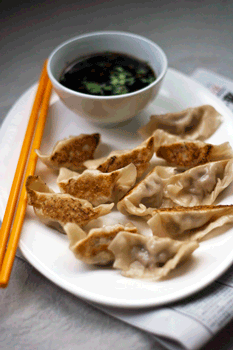SHANGHAI GUOTIE POT STICKERS
The word for “pot stickers” in Chinese is guotie, literally “pot-stick,” a name they have earned from their cooking method. Chinese cooks first steam guotie in giant flat-bottomed iron pans. When all the water is absorbed by the dumplings, they are left in the pan to get crispy and “stick” to the pan. We recommend using a nonstick skillet when making these so that the dumplings don’t actually stick to the pan forever. These Guotie Pot Stickers make amazing appetizers served with the dipping sauce. We like to make more dumplings than we can eat and freeze the extra for later.

Makes about 36 dumplings
Dipping Sauce
1 cup Chinese black rice vinegar
1/2 teaspoon minced fresh ginger
1 teaspoon toasted sesame oil
1 tablespoon minced fresh cilantro
1/4 cup light soy sauce
1 tablespoon sugar
Dumplings
12 ounces ground beef or ground pork
1 tablespoon light soy sauce
1 tablespoon cornstarch
1 teaspoon minced fresh ginger
3/4 cup minced green onions, green and white parts
1/2 teaspoon sugar
2 teaspoons toasted sesame oil
Pinch of salt
About 36 round Dumpling Wrappers
(purchased premade, or see page 258)
3 tablespoons vegetable oil
3/4 cup water
To make the dipping sauce, whisk together the black rice vinegar, ginger, sesame oil, cilantro, soy sauce, and sugar in a small bowl. Set aside.
To make the dumplings, combine the meat, soy sauce, cornstarch, ginger, green onions, sugar, sesame oil, and salt in a bowl and stir in one direction with a chopstick until just mixed. Fill a small bowl with some water. Hold a dumpling wrapper in the palm of your hand and place 1 heaping teaspoon of filling in the center. Dip your finger in the bowl of water and run it around the edge to help make a good seal. Lightly fold the wrapper over on itself, but don’t touch the edges together. Starting at one end, use your fingers to make a small pleat on the side of the wrapper closest to you, then press the pleat into the other side and pinch together firmly. Keep making pleats down the dumpling opening in this way until completely sealed (see Dumpling Folding Tips on page 255). Repeat this process with the remaining filling and wrappers. Freeze any dumplings that you don’t intend to cook immediately (see Dumpling Freezing Tips on page 256).
Heat 1 tablespoon of the vegetable oil in a nonstick skillet over medium-high heat. Place 12 dumplings pleat side up in the pan so that they are just touching each other. Cover and cook for 1 minute. Decrease the heat to medium-low, pour 1/4 cup of the water into the pan, and cook, covered, for 8 to 10 minutes, until all the water is absorbed by the dumplings and their bottoms are crusty brown. Repeat this process 2 more times with the remaining dumplings, oil, and water. Serve the dumplings with a side of the dipping sauce.
MACANESE FRIED RICE
Walking along the waterfront down the Rua das Lorchas, past pastel stucco apartment buildings splashed with freshly washed clothes dancing and drying in the sun and the occasional window box bursting with red and pink geraniums, the pungent smell of drying fish assaults my nostrils. All along the sidewalk, salted fish are laid out on woven wooden trays baking in the direct sunlight. Dried fish, especially bacalao (salt cod), is one of the many ingredients introduced by Macau’s Portuguese colonists and is an important component in Macanese cooking. In the fifteenth century, Portuguese fishermen came up with a way to preserve surplus fish by salting and sun-drying them on the decks of their ships.
To me, this dish is the essence of Chinese-Portuguese fusion. Fried rice, a distinctly
Chinese dish, is fused with Mediterranean black olives, chorizo, and salt cod. Bacalao is used primarily as a flavoring agent in Macanese fried rice; however, it is difficult to find and prepare. We substitute a dash of Asian fish sauce in its place in this recipe, which gives the rice a similar flavor, but if you can find bacalao (or its Italian equivalent, baccalà) at a fishmonger or specialty food store, substitute 3 ounces (rehydrated and chopped) for the Asian fish sauce.

Serves 4 to 6
1/4 teaspoon sugar
1 tablespoon Asian fish sauce
Juice of 1/2 lime
3 tablespoons olive oil
3 cloves garlic, minced
1 small onion, thinly sliced into half-moons
2 large eggs, beaten
3 cups cooked long-grain white rice, chilled (see page 257)
1 small green bell pepper, seeded and thinly sliced
1/2 cup corn kernels (fresh or frozen and thawed)
4 ounces chorizo sausage, thinly sliced
1/3 cup pitted green olives
In a small bowl, combine the sugar, Asian fish sauce, and lime juice and stir until the sugar is dissolved.
Heat the oil in a wok over high heat. Add the garlic and onion and sauté for 3 minutes, or until the onion starts to turn translucent. Pour in the eggs and scramble until they are just set, and then immediately toss in the rice and stir until well mixed. Decrease the heat to medium and add the bell pepper, corn, chorizo sausage, olives, and the sugar mixture, and stir-fry for 3 minutes. Remove the wok from the heat and let rest for 4 minutes before serving.
—From Feeding the Dragon: A Culinary Travelogue Through China with Recipesby Nate and Mary Kate Tate/Andrews McMeel Publishing
